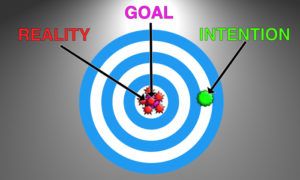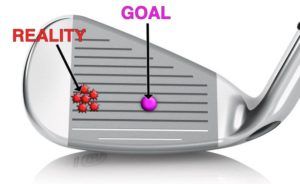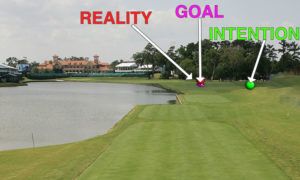
This is a guest post by Adam Young, author of the bestselling book The Practice Manual
Every golfer is chasing consistency. Yet, one of the most vital components of consistency may not be what you think – it may even be completely counter to what you think.
Adaptability.
Evolution is simple – the conditions (environmental) are constantly changing. The organism that is more adaptable survives. How does this apply to your golf game?
What I will explain here is one of the simplest concepts which all good players understand, yet I consistently see average golfers that just don’t “get this”.

AN ANALOGY
Imagine you are at a shooting range. You take dead aim at the bullseye, line it up through the sight and shoot – you miss to the left.
You continue to shoot and the same thing keeps happening – it’s clear the sight of the gun is misaligned.

In the above pic, you are aiming the gun at the purple centre, but your shot patterns are left of that
HERE’S THE DIFFERENCE
The difference between your goal and your reality can also be called the difference between feel and real. In other words, you are feeling as though you are doing something (firing at the bullseye), but your reality tells a different story.
One of the biggest differences I see between a poor player and a good player, is that the poor player will partake in Einstein’s definition of insanity
Try to do the same thing over and over and expect a different result
That’s right, the poor player will continue to shoot at the bullseye and continue to hit the left of the target. Think about how this applies to golf.
BETTER PLAYERS
You could argue that better players don’t have this difference between what they perceive is happening and reality, but that is patently false. It might not be as large a difference, but it is always there. As a pretty decent player myself, I can attest to the fact that what I am trying to do and what I actually do are often skewed.
But better players are quicker to
- Identify the reality (what is happening)
- Make a change to shift the reality
- Know how much of a change to apply
The better player would understand that the sight of their gun is off, and then would re-adjust their aim accordingly. They change their intended target so that reality matches their goal.

In the above picture, the player has shifted their intended target to the right side of the board, to allow for the difference between their perception and reality.
INTENTION-ACTION
Think of the sight of the gun as being your perception.
A good golfer will do anything to make the result match up with their goal. This includes changing their intention – although this skill of shifting their intention is often so deeply ingrained that a top player may now be unaware that they are doing this.
The gap between intention and reality can be a form of what we call “Perception – Action coupling” (although this phrase is often more all-encompassing). Let’s rephrase this to intention-action coupling.
As a professional golfer, I know that our intention-action coupling is constantly shifting around from day to day, and hour to hour. This means I am constantly shifting my intention around in order to get my desired reality – a process of constant calibration. As I said, for me (now) this process is much more subconscious, but an amateur may have to be more aware of what is happening and direct this process more consciously.
I could be in the middle of a round and, for whatever reason (tiredness perhaps) a new shot pattern creeps in. Perhaps a toe patten starts to occur.

I may start out a round of golf with the goal (subconsciously) of hitting the middle of the face – but for whatever reason, my reality is off, and more toe-biased.
My first port of call in this situation is to simply become aware of what is happening. Often, this awareness in itself will start to change the pattern. But sometimes (for example, on the course), you need to get the reality working NOW, or you are not going to get around in a decent number.
If the pattern is problematic enough, I simply change my intention so that my reality matches my goal.

So, I may think about moving the strike more towards the heel (intention) in order to shift my reality towards what I want (the goal)
Again, this is what separates amateurs from guys who get it done regardless of how their intention-action coupling is. An amateur will just write off the round saying “oh, I was just off today”. A better player will find a way to make it work. Hell, I have had some of my best rounds when I am fighting a poor pattern.
AN EXAMPLE
Whenever I pick up a ladies club during demonstrating in a lesson (sometimes this is the only club at hand), I am more prone to hitting it out of the toe (due to shaft flex differences). However, I learned to quickly adapt my intention whenever I demonstrated with a ladies club, so that I am able to hit out of the sweetspot.
In other words, whenever I pick up a ladies club, I intend (try) to hit the ball more towards the heel, so that the result is a sweet shot.
What is interesting is that, because I have demonstrated with ladies clubs for so long, I don’t even have to think about this process anymore. I just pick up a ladies club, and my subconscious mind takes care of the rest. But, initially, it had to be a conscious intention. This is a concept called perceptual adaptation, which I will discuss in a different article.
WHY IS THIS IMPORTANT?
Quite simply, having this skill allows a golfer to still play well when they are
- Not hitting the ball where they intend to on the face
- Not contacting the ground where they want to
- Slicing/hooking the ball unintentionally
- Using clubs they are unfamiliar with (such as a holiday rental set)
- When their perception changes due to tiredness
- When their perception changes due to fear
And as we are a different person from day to day due to perception shifts,
If you don’t have the ability to shift your intention so that reality matches your goal, you are going to be inconsistent.
Hell, the only reason I am able to get the ball around in par or better is because of this ability. Without it, I would be doomed to play with whatever patterns turn up on the day and I would probably never break 85. If you have this ability, you can turn a bad day into a good day quite easily.
DANCE WITH THE LADY
I think it was Jack Nicklaus who once said, "You have to dance with the lady you brought."
What this phrase means is that, from day to day, you are going to get a different pattern (lady) turn up. Some days you will be slicing it more, other days you might be pulling it more. In fact, here is a video of Tiger Woods talking about the same thing;
If you want to listen to the original video, the 12 minute version is here
Again, this is another form of intention shift so that your reality matches your goal – something all great players can do if they need to.
Imagine the below scenario, you are standing on the 18th at Sawgrass and you have to make a bogey to win the event. You have been struggling all day hitting the ball more left than your goal. Based on this, if you were to aim down the middle of the fairway, it is likely you would plop it in the water.

Basically, the lady you brought to the table is one which hits the ball more left than your intention. Now, while you could obviously make a mid-round mechanical change, this tends to open up a bigger spread of pattern – in other words, your results might be shifted more towards where your goal is, but at the cost of a wider dispersion.
It might be a better goal to listen to Jack Nicklaus and Tiger woods (and me) and Dance. By shifting your intention, you shift the reality. Tiger Woods, in the video, said
"I shift my aim points"
What he means by this is, instead of fighting his pattern, he just shifts where he aims (his intention), as shown below.

By mentally aiming at the right rough, you will tend to shift your pattern more towards that area. Remember, this is an intention shift – if you simply physically aim at the right rough but then try to swing towards the target, you may end up hitting it in the water still. Good players have (and have developed) this skill of being able to shift perception/intention around.
IT STARTS WITH AWARENESS
In order to develop this ability to adapt, we need a few things in place
- An awareness of what is going on (shot patterns, strike patterns etc)
- An ability to change
- Ability to know how much to change
- You need to be comfortable with adapting
Let’s have a look at each in brief detail.
AWARENESS
In order to build awareness of what is happening, you need good quality feedback. Without feedback, it’s like trying to learn to play darts without ever seeing the board. I find the vast majority of golfers above 5-8 handicap cannot give good information as to what actually happened at impact. In fact, the majority consistently think that something completely different has happened.
Keep track of shot patterns and strike patterns. I show ways of doing this in “The Practice Manual”
ABILITY TO CHANGE
You also need an ability to create a desired change. For example, can you intentionally move the strike pattern around the face? Can you hit with a more open and closed club face? Can you hit the ball more left and right at will? Can you brush the ground with different depths and in different places?
Differential practice is massively helpful in this regard, as is variability practice.
KNOW HOW MUCH
Having an ability to change is one thing, but controlling the amount that you change is really what separates players. For example, if you are hooking the ball, you may know that your club face is too closed to the path and that you can turn it into a manageable draw by getting the face more open. But how much do you open the face? How much do you have to shift your perception to create the desired change?
Again, feedback, awareness all help in this process, as does practicing problem solving via random practice,variability practice and differential practice.
COMFORT
Making a change is very difficult if the situation is more stressful, such as on the course in a competition.
Knowing what change to make and in what dosage is one thing – but what if your comfort levels stop you making that change? If you have never practiced the act of changing (through variability and differential practice) and have only ever stuck to the old dogma of “Perfect practice makes perfect”, you are going to be pretty screwed when something pops up mid-round and you have no idea how, or how much to change it.
For more info on differential, variability and random practice, as well as ways of improving feedback and making perception shifts, “The Practice Manual – The Ultimate Guide for Golfers” is packed full of info. Click below for more info

CLIFF NOTES
- What you do (reality) and what you think you do (intention) are often different
- In order to get reality into your goal position, you may have to change your intention
- This might be changing a technical intention (such as trying to hit a different part of the face), or may involve changing your strategic intention (such as aiming at a different part of the fairway/green to allow for a shot pattern)
- Key skills are
- Awareness
- An ability to change things
- An ability to change it the right amount
- Sufficient comfort levels with changing as to be able to implement it on the course when needed.
Adam is a golf coach and author of the bestselling book, "The Practice Manual: The Ultimate Guide for Golfers." He currently teaches at the Leadbetter Academy at La Manga Resort in Spain, and has spent many years researching psychology, nutrition, biology, neuropsychology, evolutionary learning, motor learning theory, and skill acquisition. He aims to combine this knowledge with the technical expertise he has acquired in order to improve the way golf is learned and potential is achieved.
Visit his website www.adamyounggolf.com for more information on how to take your game to the next level with the latest research.
[/author]
We care about the protection of your data Read our Privacy Policy